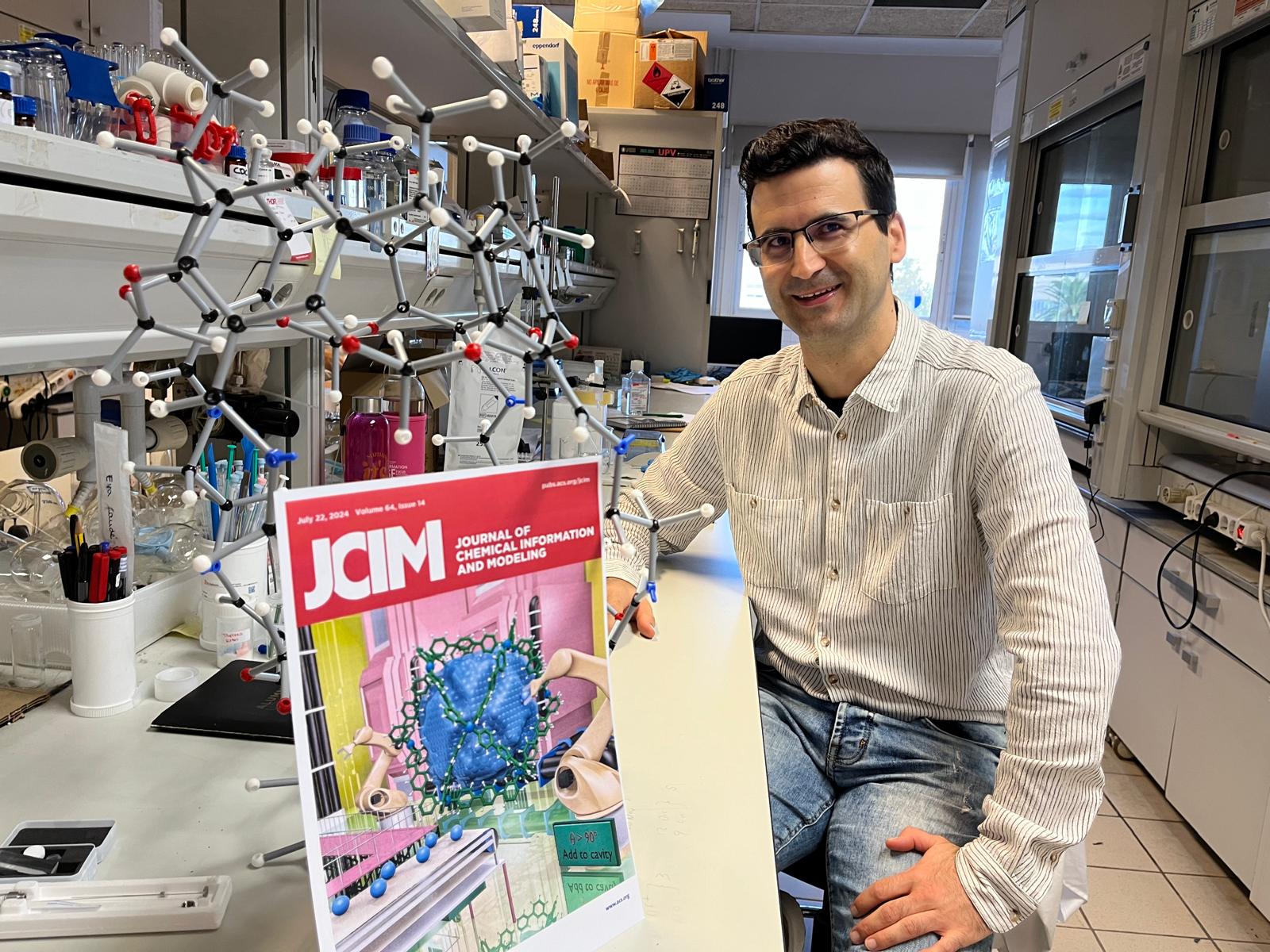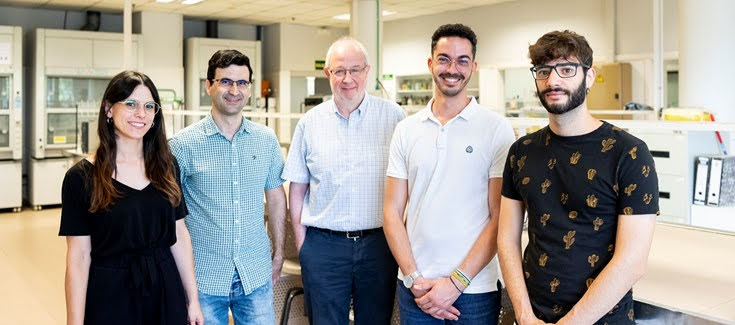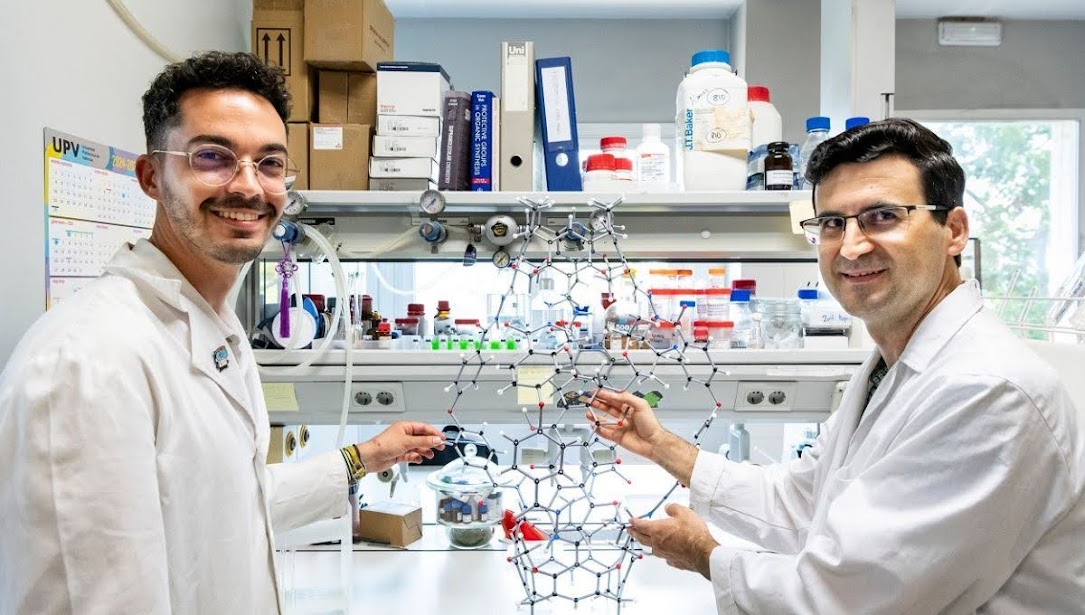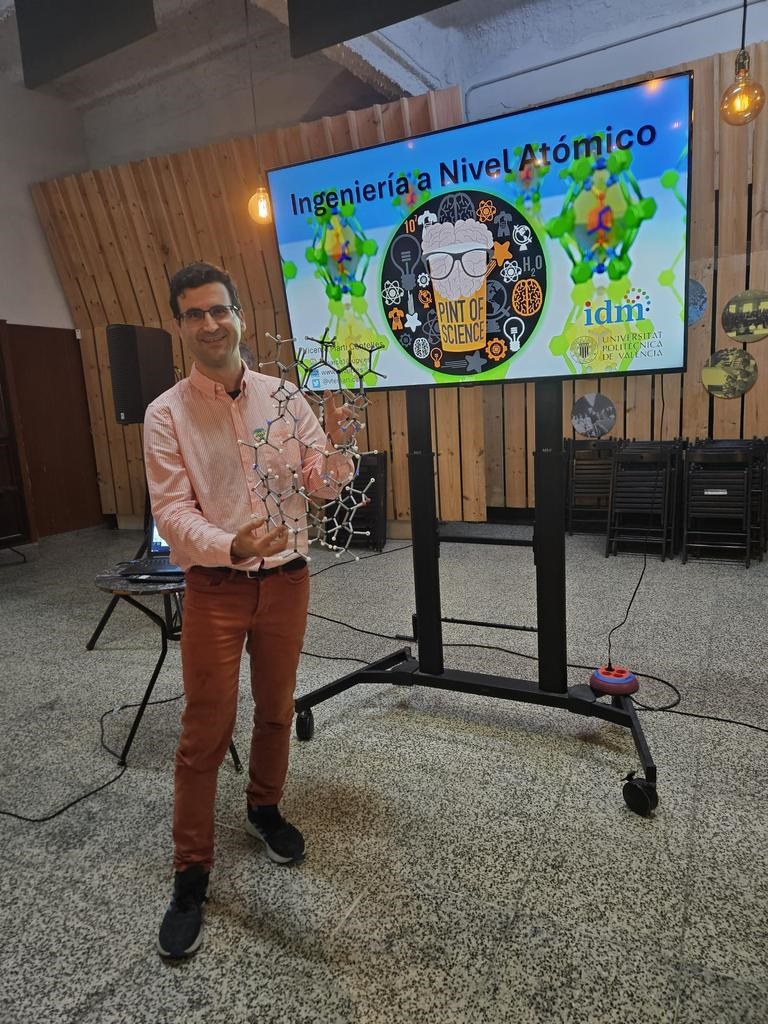Advanced Molecular Encapsulation for Drug Delivery in Cancer Treatment (AdMolEc)
Funded by: MICIU/AEI/10.13039/501100011033 and European Union NextGenerationEU/PRTR (project CNS2023-144879)
Vicente Martí Centelles current research interests focuses on supramolecular systems based on molecular cages for advancing the field of cancer therapy. The project will develop advanced molecular encapsulation systems for drug delivery in cancer. The project AdMolEc is funded by the Convocatoria 2023 - «Incentivación de la consolidación investigadora» de la Angencia estatal de investigación y Ministerio de Ciencia e Innovacion (MICIU/AEI/10.13039/501100011033 and European Union NextGenerationEU/PRTR, project CNS2023-144879).



In this research project, we propose a multidisciplinary approach using cutting-edge knowledge from chemistry to medicine to harness the remarkable properties of molecular cages for cancer therapy, providing enhanced stability and pharmacokinetics of encapsulated drugs.

News
Researchers from the Universitat Politècnica de València and the University of Oxford have designed software that facilitates the design of molecular cages for drug encapsulation
-

CageCavityCalc (C3): A Computational Tool for Calculating and Visualizing Cavities in Molecular Cages. Cover of the journal with Vicente Martí Centelles in the lab.
By improving the design of the cages, the software makes the encapsulation and subsequent release of drugs in the body more efficient
The work was on the cover of the Journal of Chemical Information and Modeling last July A team from the Institute of Molecular Recognition and Technological Development (IDM) of the Universitat Politècnica de València (UPV) and the University of Oxford has developed new software that, among many other applications, facilitates the design of molecular cages for drug encapsulation.
Called CageCavityCalc -C3- this software specifically allows the automated calculation and visualization of the cavity size of molecular cages used in biological applications and which are used, for example, for the administration of anticancer drugs. The work was featured on the cover of the Journal of Chemical Information and Modeling last July. "The CageCavityCalc software uses a novel algorithm that allows the calculation of the cavity size of molecular cages and properties such as hydrophobicity and electrostatic potential, which provides key information to optimize the design of the molecular cage that houses the drugs, for their subsequent release into the body in the most efficient way possible," explains Vicente Martí Centelles.
Molecular cages are also used in other applications such as sensors and molecular recognition, catalysis, etc. The fundamental key to their optimal functioning lies in their internal cavity, so that they are capable of encapsulating guest molecules and modulating their properties. "However, today, the design of cages with specific properties is a challenge and the development of software that helps predict the properties is essential. And our work responds to this challenge," highlights Vicente Martí Centelles.
According to the IDM researcher, to date the calculation of molecular properties and cavities requires the use of "command line"-based software and parameter adjustments by the user. Meanwhile, CageCavityCalc has a graphical interface that allows non-specialists to use this tool without needing to have computer programming knowledge. In addition, the cavity calculation is completely automated, which avoids the need to make parameter adjustments to perform the calculation. "The main advantage of the CageCavityCalc software is its efficiency and ease of use, in addition to being free and open source. It speeds up cavity calculations, thus facilitating the development of new functional molecular cages, with the appropriate properties for their different applications. In short, it greatly simplifies the design of these cages, while optimizing their operation," concludes Vicente Martí Centelles.
Reference
Vicente Martí-Centelles,* Tomasz K. Piskorz, Fernanda Duarte.*. CageCavityCalc (C3): A Computational Tool for Calculating and Visualizing Cavities in Molecular Cages. J. Chem. Inf. Model. 2024, 64, 5604-5616. Journal cover feature. DOI: 10.1021/acs.jcim.4c00355
Molecular cages to improve the effectiveness and reduce the toxicity of anticancer drugs
-

Molecular cages to improve the effectiveness and reduce the toxicity of anticancer drugs
-

Molecular cages to improve the effectiveness and reduce the toxicity of anticancer drugs
-
Molecular cages to improve the effectiveness and reduce the toxicity of anticancer drugs
Molecular cages to improve the effectiveness and reduce the toxicity of anticancer drugs | Aug 5th, 2024 Watch complete video
A team from the Universitat Politècnica de València (UPV), CIBER-BBN and the University of Edinburgh has just published a strategy based on the use of molecular systems for the encapsulation and release of drugs with possible applications in future cancer therapies. In their study, they encapsulated an anticancer drug in a molecular cage that responds to changes in pH and verified its effectiveness against cancer cells. Their results have been published in the journal Chemical Science, which has also selected the project for one of its inside covers.
Molecular cages are structures that completely envelop the host molecules, in this case encapsulating a drug and leaving it in an inactive state for its subsequent release - recovering its activity.
The study, which has been developed as part of Giovanni Montà's doctoral thesis project, has allowed the start of the line of research into molecular cages for biological applications.
"In our research, evaluated in vitro tests on cells, we have carried out a comparative analysis between two analogous cages: a metal-organic cage and another organic cage. This is a unique study, of great relevance to be able to advance which type of cage is better for biological applications and, in this specific case, to fight against these cancer cells," explains Giovani Montà
For future developments of anti-cancer drug release systems
In their study, the IDM-UPV and CIBER-BBN team, in collaboration with Paul Lusby of the University of Edinburgh, has verified that the organic molecular cage has better properties than the metal-organic cage, and allows better administration of the drug due to its lack of toxicity.
Vicente Martí, researcher at the IDM-UPV and CIBER-BBN, explains that the organic cage stands out for its high cellular compatibility, since it does not show any cellular toxicity even at high doses, unlike the metal-organic cages, in which toxicity was observed.
"In addition, the organic box delivers the anticancer drug doxorubicin effectively to the cells, preserving the cytotoxic activity of this anticancer drug," says David Bastante, a predoctoral researcher at the IDM-UPV.
In this way, according to Alba García, a CIBER-BBN researcher, this study establishes the basis for future developments of drug release systems based on molecular boxes, applied to the treatment of pathologies such as cancer.
Following the good results of the system developed in its laboratories, the IDM, CIBER-BBN team continues to work on improving its properties. "Our goal is to obtain a system that allows us to advance in biological applications, and to be able to carry out in vivo tests," concludes Ramón Martínez-Máñez, director of the IDM Institute at the UPV and also a CIBER-BBN researcher.
Reference
Giovanni Montà-González, David Bastante-Rodríguez, Alba García-Fernández, Paul Lusby, Ramón Martínez-Máñez,* Vicente Martí-Centelles*. Comparing Organic and Metallo-Organic Hydrazone Molecular Cages as Potential Carriers for Doxorubicin Delivery. Chem. Sci. 2024, 15, 10010-10017. Journal cover feature. DOI: 10.1039/D4SC02294G
Pint of Science
-

Pint of Science
Vicente recently gave a talk at Pint of Science in Valencia 2024, where he discussed topics in chemistry, specifically focusing on nanomaterials and molecular cages. Pint of Science is a global science festival that connects researchers with the public in local bars and cafes.
During his presentation, Vicente explained the potential of nanomaterials, which are small structures with applications in fields like medicine and energy production. He also covered molecular cages, chemical structures that can trap and release molecules, with uses in drug delivery among other fields.
The talk provided an opportunity for the public to learn about these topics in an informal setting. Vicente communicated these concepts, making them accessible among the audience. The event highlighted the importance of science communication, showing how scientific ideas can be shared in an engaging way.
Publications
|
|
Giovanni Montà-González, Ramón Martínez-Máñez,* Vicente Martí-Centelles* Synthesis of a Pd2L4 Hydrazone Molecular Cage Through Multiple Reaction Pathways Int. J. Mol. Sci. 2024, 25, 11861. DOI: 10.3390/ijms252211861 |
|
|
Giovanni Montà-González, Ramón Martínez-Máñez,* Vicente Martí-Centelles* Requirements of Constrictive Binding and Dynamic Systems on Molecular Cages for Drug Delivery Targets, 2024, 2, 372-384. DOI: 10.3390/targets2040021 |
|
|
Vicente Martí-Centelles,* Tomasz Piskorz, Fernanda Duarte* J. Chem. Inf. Model. 2024, 64, 5604-5616. Journal cover feature. DOI: 10.1021/acs.jcim.4c00355
|
|
|
Giovanni Montà-González, David Bastante-Rodríguez, Alba García-Fernández, Paul Lusby, Ramón Martínez-Máñez,* Vicente Martí-Centelles* Chem. Sci. 2024, 15, 10010-10017. Journal cover feature. DOI: 10.1039/D4SC02294G
|
|
|
Giovanni Montà-González, Eduardo Ortiz-Gómez, Rocío López-Lima, Guillermo Fiorini, Ramón Martínez-Máñez,* Vicente Martí-Centelles* Water-Soluble Molecular Cages for Biological Applications Molecules, 2024, 29, 1621. DOI: 10.3390/molecules29071621 |
Resarch Team
PI of the project: Dr. Vicente Martí-Centelles
-

Vicente Martí Centelles
Dr. V. Martí-Centelles graduated in Chemistry with honors in 2007 (Univ. Jaume I, Spain). He got a Spanish Ministry of Education grant to develop his PhD on new pseudopeptidic macrocyclic hosts for molecular recognition under the supervision of Profs. S.V. Luis and. M.I. Burguete at Univ. Jaume I with two research stays with C. Cativiela (Univ. Zaragoza) and R. Vilar (Imperial College London). He received his PhD with honors in 2012. He got a postdoctoral grant from the Generalitat Valenciana in 2013 to work at Univ. Jaume I (Prof. S.V. Luis), Oxford Univ. (Prof. P.D. Beer) and the company Biotica (Legionella detection). Then he joined the Paul Lusby research group at Univ. of Edinburgh in 2015. In October 2018 he moved to Univ. Bordeaux / CNRS to work in the Nathan McClenaghan research group as a Marie Curie fellow. In 2020 Dr. Martí obtained a CIDEGENT Distinguished researcher from Generalitat Valenciana to develop his own project on molecular cages for cancer therapy as principal investigator at Instituto de Reconocimiento Molecular y Desarrollo Tecnologico (IDM), Universidad Politécnica de Valencia.
Infrastructure
Our research is developed at the laboratories of the Interuniversity Institute for Molecular Recognition and Technological Development located at Universitat Politècnica de València that has all the facilities to develop synthetic chemistry (lab space equipped with fumehoods, NMR, UV-Vis, fluorimeter, TGA, RX, etc.). Additionally, the research group has access as internal users to different institutions for further facilities and equipment. This includes advanced NMR, microscopy, cell culture, etc.
The Interuniversity Institute for Molecular Recognition and Technological Development was created by the Valencian Government (IDM) was created in 2015 as an Institute of Interdisciplinary Research between the Universitat Politècnica de València and the Universitat de València.
Work with us
Prospective PhD and postdoctoral researchers are welcome to contact Dr. V. Martí-Centelles by e-mail for further information and how to apply. At the moment we are looking for candidates interested in applying to a Marie Sklodowska-Curie Actions Postdoctoral Fellowships (MSCA-PF) for developing molecular cages integrating chemisrty and biology.
Funding
Advanced Molecular Encapsulation for Drug Delivery in Cancer Treatment (AdMolEc). Project CNS2023-144879 funded by: MICIU/AEI/10.13039/501100011033 and European Union NextGenerationEU/PRTR.
Convocatoria 2023 - «Incentivación de la consolidación investigadora» de la Angencia estatal de investigación y Ministerio de Ciencia e Innovacion (MICIU/AEI/10.13039/501100011033 and European Union NextGenerationEU/PRTR, project CNS2023-144879).









